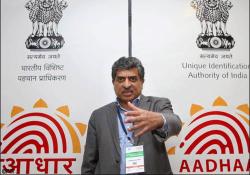 | « Back to article | Print this article |
On October 20, Prime Minister Manmohan Singh is scheduled to launch the first major step in integrating the Unique ID, or Aadhaar, with government welfare schemes. The event is supposed to take place in Dudu, a town in Jaipur district in Congress-ruled Rajasthan.
 The presence of Congress President Sonia Gandhi also seems to suggest that the United Progressive Alliance will likely use the roll-out of Aadhaar-linked schemes as part of the achievements it will try and sell to voters come re-election time.
The presence of Congress President Sonia Gandhi also seems to suggest that the United Progressive Alliance will likely use the roll-out of Aadhaar-linked schemes as part of the achievements it will try and sell to voters come re-election time.
Five welfare programmes are due to be linked to Aadhaar immediately: the Mahatma Gandhi National Rural Employment Guarantee Act (MGNREGA), the Gramin Awas Yojana that helps build rural houses for families living below the poverty line, the senior citizens' pension scheme, payments under the Asha Sahyogini programme and the Chief Minister's Scholarships.
Apart from MGNREGA and, possibly, pensions, these are not the sources from which most savings and convenience from Aadhaar are expected, indicating a certain avoidable timidity on part of the government.
The Unique ID has received a great deal of negative publicity and adverse comment, from parliamentary committees to activists concerned about privacy, to those within government who thought it was competition for the National Population Register being carried out by the Census department of the home ministry.
More recently, reports emerged from the various pilot trials of Aadhaar that the biometric machines were having trouble identifying some fingerprints, and that the recognition rate was not up to scratch.
Other central ministries have expressed concern that using wireless technology as part of the Aadhaar backbone will exclude districts without sufficient mobile telecommunications penetration. That the government is nevertheless going ahead to some extent is creditable.
A fortnight ago, the Prime Minister's Office (PMO) announced a set of inter-ministerial committees that would lay out the road map for some uses of Aadhaar. The actual linkage of five welfare schemes to the Unique ID in several districts across the country - in five different states - is the natural next step.
The government must, in effect, ignore the criticism and the concern that Aadhaar is "incomplete". Transformative technologies of this kind can only be properly tweaked once they have been rolled out, and are subjected to use by non-experts in the field.
It is also necessary to note that, even if the government can continue to summon the courage to move forward, it does not seem to be doing so on some of the most anticipated and useful applications of Aadhaar. In particular, the PMO carefully avoided mentioning food and fuel subsidies in its discussion of the cash transfer architecture it released recently.
In a more recent speech, the prime minister referred specifically to "non-cash transfers" as another location for Aadhaar-based efficiency. True, the government need not hold Aadhaar hostage to reform of food or fuel subsidy delivery. But the option should be kept open.
These recent statements do not inspire hope. Yet pilot projects showed impressive savings: a cash transfer experiment for cooking gas in Mysore saw a 40 per cent drop in connections; and in Alwar district of Rajasthan, kerosene consumption went down by 80 per cent in another pilot project.
Even as the government evaluates the impact of UID on the field, these savings - so crucial when it comes to controlling the subsidy bill - should not be ignored. Food and fuel subsidies must be part of the Aadhaar cash transfer architecture.